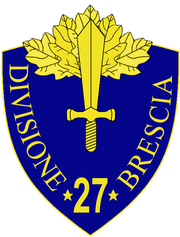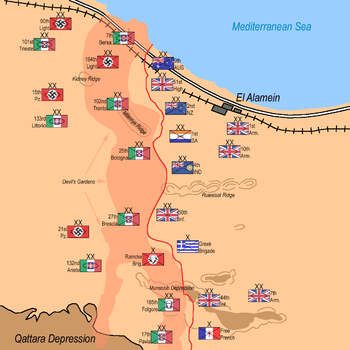27th Infantry Division Brescia
The 27th Infantry Division "Brescia" (Italian: 27° Divisione Autotrasportabile "Brescia") was an auto-transportable Infantry Division[nb 1] formed 1 January 1935 as 27th Infantry Division Sila and reorganized to the 27th Infantry Division "Brescia" 24 May 1939.
It was made up of draftees from Calabria. The Brescia was classified as an auto-transportable division, meaning staff and equipment could be transported on cars and trucks, although not simultaneously.
| 27th Infantry Division Brescia | |
|---|---|
 27th Infantry Division Brescia Insignia | |
| Active | 1939–1943 |
| Country | Italy |
| Branch | Italian Army |
| Type | Infantry |
| Role | infantry |
| Size | Division |
| Part of | Italian XXI Infantry Corps |
| Garrison/HQ | Catanzaro |
| Nickname(s) | Brescia |
| Engagements | World War II Siege of Tobruk Battle of Gazala Second Battle of El Alamein |
The division was part of the Italian XXI Infantry Corps in the North Africa. along with the 17 Motorised Division Pavia and the 25 Motorised Division Bologna together they took part in the Siege of Tobruk, the Battle of Gazala, the Battle of Mersa Matruh, the First Battle of El Alamein and the Second Battle of El Alamein.
History
Second Italo-Ethiopian War
Already in Ethiopia in October, 1935, the division Sila have participated first in the capture of Mek'ele. From 4 November 1935, it has stationed in the Adigrat. In December, 1936, some local fighting has happened at the line Ādī K’edawīt - Passo Doghea line.[1] Also, reconnaissance raids were carried to Ziban Debrī Bota and Celecot. 19 January 1936, the Sila division have broken through the Ethiopian defences, capturing several towns in the Tembien Province. It did not participate in the nearby First Battle of Tembien though and acted only in the final stages of Battle of Amba Aradam, capturing Āmba Ālagē 26 February 1936. In March, 1936, the Sila division has spread to Finarwa - Sek'ot'a region where it stayed until the end of war.
Second World War
24 May 1939, the division Sila was renamed Brescia and received a 1st mobile artillery regiment instead of normal infantry artillery regiment. By the June, 1940, the Brescia was located around Zawiya, Libya and fought French-supported Tunisian irregulars from 1 June 1940 until 25 June 1940. After the Franco-Italian Armistice has come into effect, the division was tasked with the coastal defence west of Tripoli. A divisional artillery was detached to fight at Mechili-Derna, Libya line 25–29 January 1941. Following failure of Italian front, it retreated through Marj and Benghazi, but was encircled north of Ajdabiya 5 February 1941. In early March, 1941, the division have consolidated at El Agheila and started a counter-offence 24 March 1941, together with German forces defeating British troops at Brega by 31 March 1941. It has entered Ajdabiya 2 April 1941, and used for the defence of the communication lines.
Siege of Tobruk
On 12 April 1941, as Italian and German forces commenced their Siege of Tobruk, the Brescia Division along with the German 3rd Reconnaissance Battalion captured the port of Bardia, taking several hundred prisoners and a large quantity of booty. But the attack have stalled and Rommel was forced to call for reinforcements. On the night of 30 April, a strong Italo-German force attacks the Tobruk defences again, and the Ariete, Brescia, 8th Bersaglieri Regiment and Guastatori (combat engineers) involved capture seven strongpoints( R2, R3, R4, R5, R6, R7 and R8).[2] On the night of 3 May, the Australians counterattack but the Italians in the form of the Trento, Pavia Divisions and some panzergrenadiers repel the attack[3] and the attackers are only able to recapture one strongpoint from the defending Italian troops[4] On the night of 16 May, the Brescia Division retaliates with the help of two platoons of the 32nd Combat Engineer Battalion and breaches the defensive perimeter of the 2/9th and 2/10th Battalions. With the obstacles removed, the Brescia troops involved, who bring flame-thrower parties and tanks, capture S8, S9 and S10 strongpoints.[5] The Australians fight back and the Commanding Officer of the Guastatori's, Colonel Emilio Caizzo is killed in a satchel attack and wins a posthumous Gold Medal for valour. Although the Australian Official History admits losing three positions, it claims the attackers were 'Germans'.[6] However, an Italian narrative has recorded:
With great skill and speed the Guastatori open three lanes in the mines and obstacles to let the Brescia Fucilieri through. Side by side with the Brescia assault troops they inflict heavy losses on the enemy and take out further strong points with explosives and flamethrowers.[7]
Australian military historian Mark Johnston states there was an "unwillingness to acknowledge reverses against Italians" in Australian official accounts.[8]
Major-General Leslie Morshead was furious and ordered the Australians to be far more vigilant in the future.[9] Among the objectives initially selected during the planning of Operation Brevity was the recapture of S8 and S9 strongpoints, but this was abandoned when it was discovered the Australians had recovered them.[10]
On 24 May, the Brescia Division which had taken over the western front of Tobruk, repelled an attacking infantry force, supported by tanks. On 2 August, another attack was launched to recover the lost strongpoints, but the attacking forces from the Australian 2/43rd Battalion and 2/28th Battalions are repulsed. This was the last Australian effort to recover the lost fortifications. As part of the besieging forces around Tobruk, the Brescia held out against British offence from 24 November 1941 until 10 December 1941[11] when the British 70th Division (Polish Independent Carpathian Rifle Brigade captured the White Knoll position) finally broke through the Brescia rearguards and lifted the siege of Tobruk during Operation Crusader. Advancing in broad daylight on 11 December, a battalion of the Brescia came within 50 yards of the 23rd New Zealand Battalion, but were cut down by the machine guns of the New Zealanders. Initial retreat was to the Ayn al Ghazālah. On 15 December, the Brescia Division held its ground at the Ayn al Ghazālah (Gazala) against the attacking 2nd New Zealand Division and Polish Brigade, allowing a strong Italo-German armoured force to counterattack and overrun the 1st British Battalion, The Buffs.[12]. 18 December, stuck with the British forces and outflanked from south, it began to retreat to Ajdabiya and reached the planned positions 22 December 1941.
Battle of Gazala
From January, 1942, the Brescia division was defending a front around Qabr al Fārigh, south-west Derna, Libya. It has moved to forward positions at Qabr al Fārigh (south of Derna, Libya in April, 1942. During the Battle of Gazala, the 'Brescia played an important role in the capture of 6,000 prisoners on 16 June 1942, after the Trieste and 15th Panzer Division had destroyed the British 2nd and 4th Armoured Brigades.[13] operating at Ghawţ al ‘Abīdī depression.
Battle of Mersa Matruh
20 June 1942, the Brescia division have passed to the south of Tobruk, and then rapidly moved through Bardia, As Sallūm and Sidi Barrani, arriving to Mersa Matruh 30 June 1942. During the brief siege of Mersa Matruh in late June 1942, the Brescia with the Trento Division and Bersaglieri troops played an important part, in the capture of 6,000 defenders of the Xth British Corps, along with large quantities of supplies.[14] 1 July 1942, the British resistance was over.
First Battle of El Alamein and Second Battle of El Alamein

From the beginning of July, the Allied resistance have mounted up. During the First Battle of El Alamein in July 1942, the Brescia deployed on El Mreir, repelled a strong force of the 5th New Zealand Infantry Brigade in the initial fighting,[15] and during the defence of Ruweisat Rige, the 19th Regiment of the Brescia put up a tenacious defence, losing a battalion and three company commanders in the night action,[16] before being partly overcome at dawn on July 15, delaying the Allied advance for several hours and allowing German armoured forces to launch a devastating counterattack[17] During the 21 July 1942, until 27 July 1942, the British counter-attacks has become so severe what the Brescia division has ultimately stopped to the south of El Alamein.
After Second Battle of El Alamein have started 24 October 1942, the Brescia was able to hold the positions against British armoured units until 4 November 1942. With the front already in disarray, it than retreated through the Deir Sha'la - Fukah route. The lack of transport means have resulted in Allied units catching up and annihilating the division Brescia remnants 7 November 1942, within the sight of the Fukah where other shattered Axis units has already gathered. The division was officially dissolved 25 November 1942.
Order of Battle Oct. 1935

- XXVII Infantry Brigade
- 16th Infantry Regiment "Savona"
- 19th Infantry Regiment "Sila"
- 20th Infantry Regiment "Sila"
- 12th Artillery Regiment (3x artillery groups with 75/13)
- 27th Machine Gun Battalion
- 12th Engineers Company
- 27th Signal Company
- 27th Replacements Battalion
- Divisional Service Units
Order of Battle June 1940
- 19 Infantry Regiment "Brescia"
- 20 Infantry Regiment "Brescia"
- 55 Artillery Regiment
- 27 Mixed Engineer Battalion
- 27 Tank Battalion [nb 2]
Notes
- Footnotes
- In the Royal Italian Army "Autotrasportabile" ("Truck Moveable" in english) meant that a division could be moved by truck by virtue of its organisation, but that it did not have the transport capacity as part of its own structure to do so, i.e. it would depend on transport being made available to it by higher headquarters to be moved by truck.
- An Italian Infantry Division normally consisted of two Infantry Regiments (three Battalions each), an Artillery Regiment, a Mortar Battalion (two companies), an Anti Tank Company, a Blackshirt Legion (Regiment of two Battalions). Each Division had only about 7,000 men, The Infantry and Artillery Regiments contained 1,650 men, the Blackshirt Legion 1,200, each company 150 men.[18]
- Citations
- http://www.regioesercito.it/reparti/fanteria/rediv27.htm
- XXXII BATTAGLIONE GUASTATORI
- The Forgotten Axis: Germany's Partners and Foreign Volunteers in World War II, J. Lee Ready, p. 310, McFarland & Co., 1987
- That magnificent 9th: An Illustrated History of The 9th Australian Division, Mark Johnston, p. 38, Allen and Unwin, 2002
- XXXII BATTAGLIONE GUASTATORI
- Maughan (1966), p.250
- GUASTATORI IN NORTH AFRICA. The XXXI and XXXII Guastatori Battalions in the North African Campaign
- Fighting the Enemy: Australian soldiers and their adversaries in World War II, Mark Johnston, p. 13, Cambridge University Press, 2002
- Maughan (1966), p.251
- Tobruk 1941, The Desert Siege, Timothy Hall, p. 183, Methuen Australia, 1984
- The Bologna Division: 19 November – 10 December, 1941 By David Aldea & Joseph Peluso, Comando Supremo: Italy at War.
- The Bologna Division: 19 November – 10 December, 1941 By David Aldea & Joseph Peluso, Comando Supremo: Italy at War.
- The Rise of the Wehrmacht: The German Armed Forces and World War, 2 Volumes, p.564, Samuel W. Mitcham, Praeger (June 30, 2008)
- Aldea, David. "Mersa Matruh". Commando Supremo: Italy at War website. Archived from the original on 2009-02-03. Retrieved 2009-04-26.
- Rommel's North Africa Campaign: September 1940-November 1942 By Jack Greene & Alessandro Massignani, Page 196, Da Capo Press, 1999
- Rommel's North Africa Campaign: September 1940-November 1942 By Jack Greene & Alessandro Massignani, Page 203, Da Capo Press, 1999
- Aldea, David. "First Battle of El Alamein". Commando Supremo: Italy at War website. Archived from the original on 2010-03-04. Retrieved 2009-04-26.
- Paoletti, p 170
- Paoletti, Ciro (2008). A Military History of Italy. Greenwood Publishing Group. ISBN 0-275-98505-9.